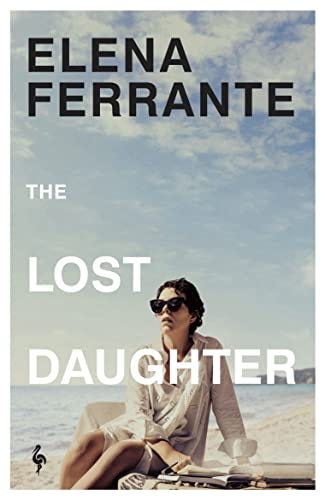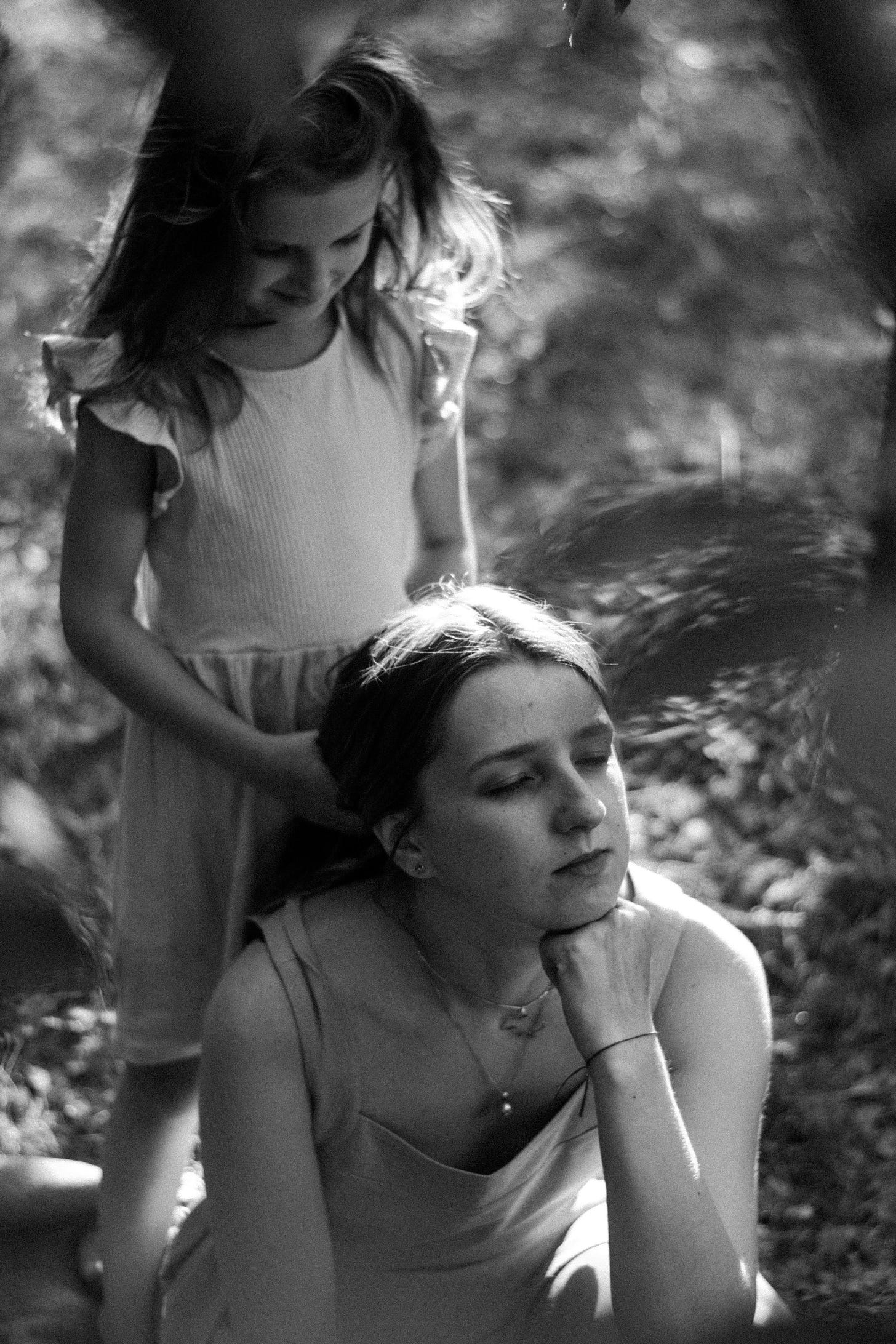Narratives on Mothering
A look at motherhood in the work of Penelope Mortimer & Elena Ferrante
Welcome to A Narrative of their Own, where I discuss the work of 20th century women writers and their relevance to contemporary culture.
I operate on a patron model to allow all my writing and research to remain here for free. If you value the work I do in uncovering the stories of women, and are in a position to support this financially from as little as £2 per month, please consider becoming a paid subscriber. Thank you for your support.
I recently read Elena Ferrante’s The Lost Daughter, (also now a film showing on Netflix), the story of a middle-aged woman named Leda who spends a holiday in an Italian beach resort and becomes strangely drawn to a large, rowdy family of Neapolitans. In particular, she appears captivated by a young mother and her daughter whom she sees playing on the beach every day, eventually crossing paths with the pair when she steals the child’s beloved doll.
I found this novel slightly strange, but what was interesting about it was the way in which it showed a somewhat ambivalent mother figure in Leda.
Leda’s obsession with the young mother, Nina, appears to set off a chain of memories of her own two daughters. She reveals to the reader that she left her own children with their father and did not see them again for three years when they were still very young. Rather than an overwhelming remorse at this, she confesses that this was just something she had to do for herself, although she does say that she returned to them when she could not bear not seeing them anymore.
The way Ferrante deals with this ambivalence on the part of Leda is interesting. I have spoken before of the ways in which literature often punishes female protagonists for their subversive behaviour, particularly in the realms of mothering. This is especially true for characters such as Edna Pontellier in The Awakening, and we are often to understand from these stories that transgression as a mother is something that will not be tolerated.
Ferrante, however, does not make Leda’s case for her. Leda is often ambivalent about her earlier decision; she also confesses that she feels relief now that her grown daughters have chosen to move to Canada to live with their father. She initially feels a sense of freedom for the first time in her life, although this lessens towards the end of the book.
“How foolish to think you can tell your children about yourself before they’re at least fifty. To ask to be seen by them as a person and not as a function. To say: I am your history, you begin from me, listen to me, it could be useful to you.”1
I loved this sentiment: it shows Leda realising that, try as we might, as mothers we can never fully hand over what we know to our daughters when they are not ready or willing to listen. It reminded me of the paragraph from Wayward, which I recently reviewed, in the mother/narrator’s own realisation towards the end of the book that her mother, herself, and her daughter are all part of a legacy of women, but that she cannot control her daughter’s life any more than her own mother could control hers.
Interestingly, as soon as I finished Ferrante’s book, I dived straight into Penelope Mortimer’s Daddy’s Gone A-Hunting, which I spied at my local library in a lovely Persephone edition.
The preface to the novel gave some interesting backstory that I hadn’t known about Mortimer, though I had heard a fascinating profile of her work, in particular her novel, The Pumpkin Eater, on a recent podcast.
Valerie Grove in the Preface to the 2008 Persephone edition paints the picture for mothers such as the protagonist within Mortimer’s novel (and indeed, Mortimer herself) as living under the weighty expectations handed down since the end of WWII. Written in 1958, she states that women were expected to remain home-makers and mothers, staying home to raise their children.
Living in an era before the arrival of second wave feminism, Mortimer’s book was written just five short years prior to the arrival of Betty Friedan’s The Feminine Mystique in 1963, which set forth a sentiment that the protagonist of Daddy’s Gone A-Hunting would have recognised: “Is this all?”
The narrator of Mortimer’s novel is Ruth, a mother of three children; two sons who are away at school and an older daughter. She feels her sanity slipping away as she contemplates the emptiness and meaninglessness of her days when she is not needed by her children or husband.
“This was why she did so much shopping.” Daddy’s Gone A-Hunting2
Grove points out that, although Mortimer would not have called herself a feminist, she was voicing the very dissatisfaction that would later be echoed by the second wave feminists.
Many of Mortimer’s novels reflect her own life, and Grove suggests that it is very difficult to separate out her own life from that of her novels. She is similar to Jean Rhys in this, though I found her writing style very different. Mortimer’s narrator Ruth appears self-aware; intelligent and conscious of her life choices. The novel also has an ironic, almost humorous tone.
Her next novel, The Pumpkin Eater written in 1961, was written shortly after Mortimer’s husband had encouraged her to terminate an eighth pregnancy and undergo sterilisation to prevent further children. Meanwhile, it was revealed that his mistress, the actress Wendy Craig, had just given birth to his son. Similar to her heroine in Pumpkin Eater, Penelope Mortimer also underwent mental health treatment, including the new, experimental treatment of ECT, similar to Sylvia Plath’s Esther Greenwood in The Bell Jar.
But Mortimer claimed that writing her novels was cathartic, putting her experiences and words into the mouths of her female characters. Writing in her Victorian semi in Swiss Cottage, she mined her turbulent marriage and experiences of motherhood for her novels and short stories, though she also wrote journalism and screenplays which featured less personal stories. She created female characters who did not have the escape hatch of an independent career or money of their own, though in reality, she continually functioned outside of her housewife and mother role to six children.
Having met and married at the age of 19, quickly becoming pregnant with her first child in 1938, in the 1940s, she had gone on to have affairs with two other men, falling pregnant with each, and by the time she met and married a 25-year-old John Mortimer, she was 30 years of age and with four daughters. She gave birth to her fifth daughter with Mortimer nine months later.
Interestingly, Grove points out in her Preface to the novel that there were a remarkably high number of female writers of the period who never experienced motherhood, citing Katherine Mansfield, Virginia Woolf, and Elizabeth Bowen amongst them. She states that Mortimer faced the usual questions by journalists and others of ‘how she managed’ to write as a mother of six children. She managed particularly well, writing a column in the Evening Standard called ‘Five Girls and a Boy’, which gave advice to other mothers on school choices, organising holidays and birthday parties. But the realities of her own life- the difficulties she faced as a mother and her husband’s infidelity- she dealt with through her novels.
In 1955, despite the Mortimer’s marriage limping on through various affairs on John’s part, Penelope gave birth to her sixth and final child, a longed-for son. After the jubilation of his birth, however, Mortimer sunk into depression, succumbing to a nervous breakdown and psycho-analysis.
“Perhaps soon I shall begin to write another book…But there’s no real confidence. I’m frightened of being smart, of not feeling sufficiently…”3
This note from her diary and others contain annotations beside them of possible future novel titles, this time as with other struggles, destined to make it into her stories.
In the late 1950s, her eldest daughter Madelon, who was reading law at Newnham College, Cambridge, fell pregnant. Mortimer refers to this in her diary also, questioning whether she should advise Madelon to marry her ‘boring boyfriend’ which would make her unhappy, or to advise her to ‘get rid of something of her own’. She eventually assisted her daughter in securing an abortion through a sympathetic GP after their own doctor refused. In true Mortimer fashion, she went on to use this incident within her writing, giving the unwanted pregnancy to Ruth’s daughter Angela in Daddy’s Gone A-Hunting.
The novel shows Ruth as she contemplates an empty house at the end of a summer, sending the boys back to school and with a frustrated and bored Angela. Her husband works in London, where he indulges in various dalliances with young and silly women, whilst Ruth deals with the unwanted pregnancy of her daughter, an Oxford undergraduate. The theme of abortion, which was still illegal, was rare in such novels, and reforms to the abortion law were not pushed through parliament until 1967, despite much campaigning during the 1950s.
Mortimer’s own daughter Madelon acknowledged her mother’s choice to fictionalise her abortion as a way her mother had of coping with reality, and the book exposes sensitively and with acute awareness the dependency and resentment which often underlies the mother-daughter relationship.
Valerie Grove makes reference to the female novelists’ who came just after Mortimer, such as Margaret Drabble, Beryl Bainbridge, and Fay Weldon. These women, amongst others, also began to combine their roles as mother/writers, leading to the coining of the term ‘the Hampstead novel’ by some male critics, referring to the novels ‘written around the kitchen table.’
“Penelope wrote about women’s lives, she said, because she was a woman. She had not the arrogance to assume a male point of view.”
The Mortimer’s finally divorced in 1971. The couple had attempted to live apart, as well as lead separate lives whilst still sharing a home, but all attempts had failed and it was time to call time on the marriage. Penelope had published My Friend Says it’s Bullet-Proof in 1969, which shows a woman rediscovering her sexuality in her forties. John Mortimer, finding himself about to start a second family with his second wife, half his age, also named Penelope but known as ‘Penny’, became the subject of Penelope’s 1971 novel The Home. A barely disguised piece of memoir, the book shows the protagonist Eleanor experiencing an acrimonious divorce whilst her husband is beginning a new relationship with a second Eleanor, known as ‘Nell’.
Penelope often referred to her ex-husband John as her mentor, and she felt his loss keenly. She claimed to have been addicted to him; neither being able to live with or without his love. She attempted to put a distance between them by taking a post teaching creative writing at Boston University in New York. During this time, she also wrote another novel, Long Distance, which she claimed to be her personal favourite, though most ‘difficult’ novel, as it details the experience of ECT on a psychiatric patient.
Her final novel, The Handyman, tackled the themes of becoming an ageing widow experiencing solitude. She had at this point found a love of gardening, claiming that her life was divided into three: “the mother of six, the ex-wife of John Mortimer, and the gardener”.
Within both Ferrante and Mortimer’s (very different) books, I find the ongoing questions around women’s choices in mothering, childbirth, and the pursuit of a creative life, still as fascinating and relevant as ever.
Elena Ferrante, The Lost Daughter, Translator: Ann Goldstein, [2006], (2021), (Europa Editions, London).
Penelope Mortimer, Daddy’s Gone A-Hunting, [1958] (2008), (Persephone Books, London).
Valerie Grove, ‘Preface’, Penelope Mortimer, Daddy’s Gone A-Hunting, (edition as above).







The latest Ian McEwan novel, Lessons, deals very surprisingly with a woman's decision to abandon her husband and baby to pursue her art. Well worth reading on this subject. Thank you Kate for such an interesting piece...my next project will be about the emergence of the wife who pursues a career, during the 1950s and 60s, and you've given me some great lines of enquiry!
This is great Kate - I was just thinking about A Lost Daughter yesterday, which I loved (I'm not usually a Ferrante fan) and your piece really makes me want to read the Penelope Mortimer now. I do love a sideways look at the theme of motherhood in mid-century novels.